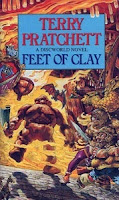 |
| (Amazon UK link) |
I last read ‘Feet of Clay’ in 2006, so had forgotten the majority of the story. I recalled that it was about ‘golems’ - a form of Discworld robot, built of clay - but had not even remembered that the main focus was on the ‘Watch’, and in particular Sir Samuel Vimes. As I read, parts of the story came back to me, but despite it being something of a ‘whodunit’ and, as it says on the back, even more a ‘howdunit’, I had quite forgotten what the outcome was.
As with most of the Discworld series, there are several threads to the story, although it’s obvious fairly early on how some of them are woven together. One of the most significant is that Lord Vetinari is ill, and it’s quickly clear that he is being slowly poisoned. But nobody can discover quite why this is happening.
Cheery Littlebottom is the latest recruit to the Watch; he (or she, as gradually becomes apparent) is a dwarf who has studied alchemy. Her skills come in very useful as she analyses food, wallpaper, linens and various other aspects of Vetinari’s room. And she’s a likeable person, too, eager to learn, and rather rejecting the typical violence and greed associated with many of her compatriots. Her gradual coming out as female (quite shocking in the Discworld dwarf world) is a sideline to the story and looks obliquely at issues of both feminism and sexism.
There’s another thread involving several of the guild leaders who are aware that Vetinari is sick, possibly fatally. None of them can agree on who might be his successor. So they discuss the possibility of a King instead of a Patrician. Captain Carrot is suggested; it’s been hinted in previous books that he might be of royal lineage, and everybody likes him. But he might just be too likeable. So someone else is proposed, and research suggests that he might even be the direct descendant of royalty…
And there’s another sideline, that of a coat of arms. Samuel Vimes’ wife, Lady Sybil, is determined that he should have one. So, early in the book, he makes an appointment to discover whether or not he can have a coat of arms.. and learns a great deal about how the system works. There’s perhaps a tad too much detail, but it turns out to be relevant to the rest of the story, though we don’t discover why until near the end.
And then there’s the golems. They function due to ‘words’ in their clay heads, which can be adjusted or removed. They’re not alive, as such, and they are treated as machines, used by several of the factories and businesses in Ankh Morpork. But they look at least vaguely human-shaped, and they have ‘holy days’ where they have to have time off.
We learn a great deal about golems in this book, and what it means to have a master - or to be free. The issue of slavery is faced, albeit with an enslaved race who are not actually alive - and in the Discworld there really are many different races; skin colour isn’t relevant at all.
Pratchett was a master at telling a story, peppering it lightly with literary and other references, pulling together apparently diverse storylines, and confronting human issues in the context of irony and humour. He pulls it off extremely well in this book, with the added bonus of the mystery of exactly how Vetinari is being poisoned.
While 'Feet of Clay' stands alone, as most of the Discworld books do, it's all the more enjoyable if read after the two earlier 'Watch' focussed books, 'Guards, Guards!' and 'Men at Arms'.
Definitely recommended.
Review copyright 2021 Sue's Book Reviews
No comments:
Post a Comment